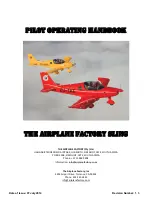
ɸ
Nano 4 user manual
________________________________________________________________________________________________________________________________________________________
ɸ
You can recognise a deep stall by the glider getting "mushy" and the airflow around your
ears decreasing. The glider may also compress spanwise. Flying in strong turbulence or
exiting a deflation with too much brake applied can cause this situation. A wet glider also has
a higher deep stall tendency, and you should do everything you can to avoid flying in the rain.
If you do pass through some rain never make big ears! Open the trimmers until you are
confident that the wing has dried out.
WARNING: Never apply the brakes, including any wraps taken, in a deep stall.
Full stall (dynamic stall)
The full stall happens when the wing partially deflates and loses its arched shape. It is
triggered when the maximum possible angle of attack is exceeded. The most common cause
is going below the minimum speed or flying near the minimum speed combined with the
effects of turbulence.
In full stall, the speedriding glider loses its forwards travel, surges backwards and deflates. If
the brakes are held down, the canopy comes up over the pilot again. The result is an almost
vertical descent with a sink rate of approx. more than 20m/s.
WARNING: Never fly stall or full stall with the Nano 4.
Spin
The spin is a stable flight maneuver, in which one side of the canopy stalls, while the other
side continues to fly forward. The glider turns around the stalled side of the wing.
WARNING: Never fly spins with the Nano 4.
Other tips for dangerous situations
Cascade
Many reserve deployments are a result of a cascade of over-corrections by the pilot. Please
note that over-corrections are often worse than no input at all.
Emergency steering (rear riser steering)
If for some reason the brake lines are not working, e.g. if the knot on the brake handle has
come undone or a brake line is defective, the Nano 4 can also be steered and landed using
the rear risers.
In this case, stall happens more quickly and the pilot must compensate for the changed
flight behaviour by pulling carefully on the risers.
Flying in the rain
We strongly advise you not to fly in the rain on any speedriding glider including the Nano 4. If
you do fly in the rain, be aware that you will have a greater risk of entering a deep stall. It is
wise to open the trimmers after passing through rain until you are confident that the glider is
flying normally, and has preferably dried out so that there is no longer any risk of deep stall.
ɸ
ɸ
ɸ
ɸ
Page 26
Summary of Contents for Nano 4
Page 1: ...Nano 4 User manual v1 0 December 2017...
Page 45: ...Dream Touch Believe...










































